Report on Budgeting Styles and Decision-Making in Organizations
VerifiedAdded on 2022/12/29
|7
|2127
|77
Report
AI Summary
This report provides a comprehensive overview of budgeting techniques used in management accounting. It begins by defining budgeting and its role in organizational decision-making, emphasizing its use in resource allocation, profitability, and growth. The report then explores various budgeting styles, including zero-based, activity-based, incremental, and value proportion budgeting, detailing their merits and demerits. It highlights the suitability of activity-based budgeting in a changing environment. The report further discusses static and flexible budgeting, explaining their uses in different situations. Finally, it examines participative budgeting, outlining its advantages and disadvantages. The report concludes by emphasizing the importance of budgeting for effective decision-making and organizational performance.
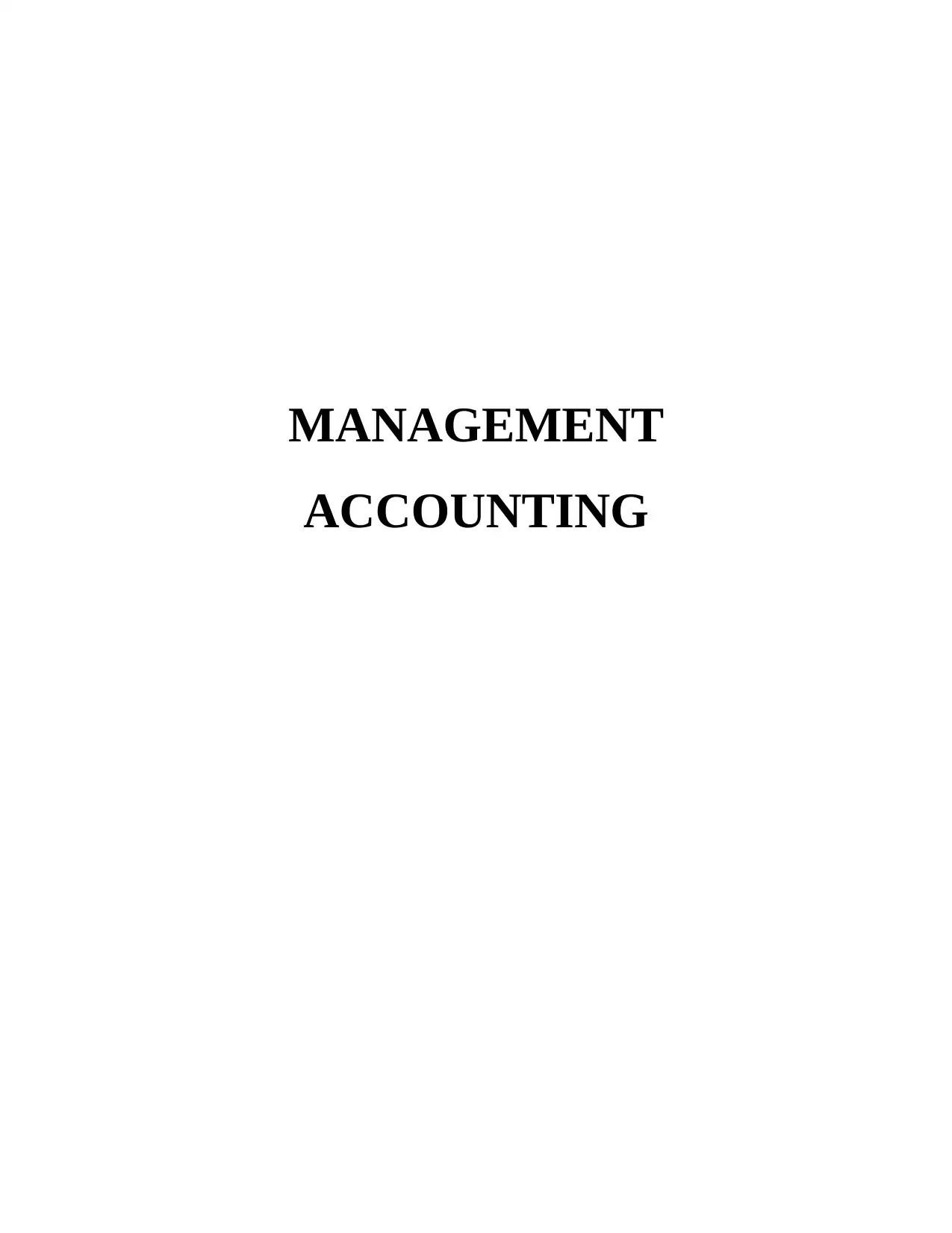
MANAGEMENT
ACCOUNTING
ACCOUNTING
Paraphrase This Document
Need a fresh take? Get an instant paraphrase of this document with our AI Paraphraser
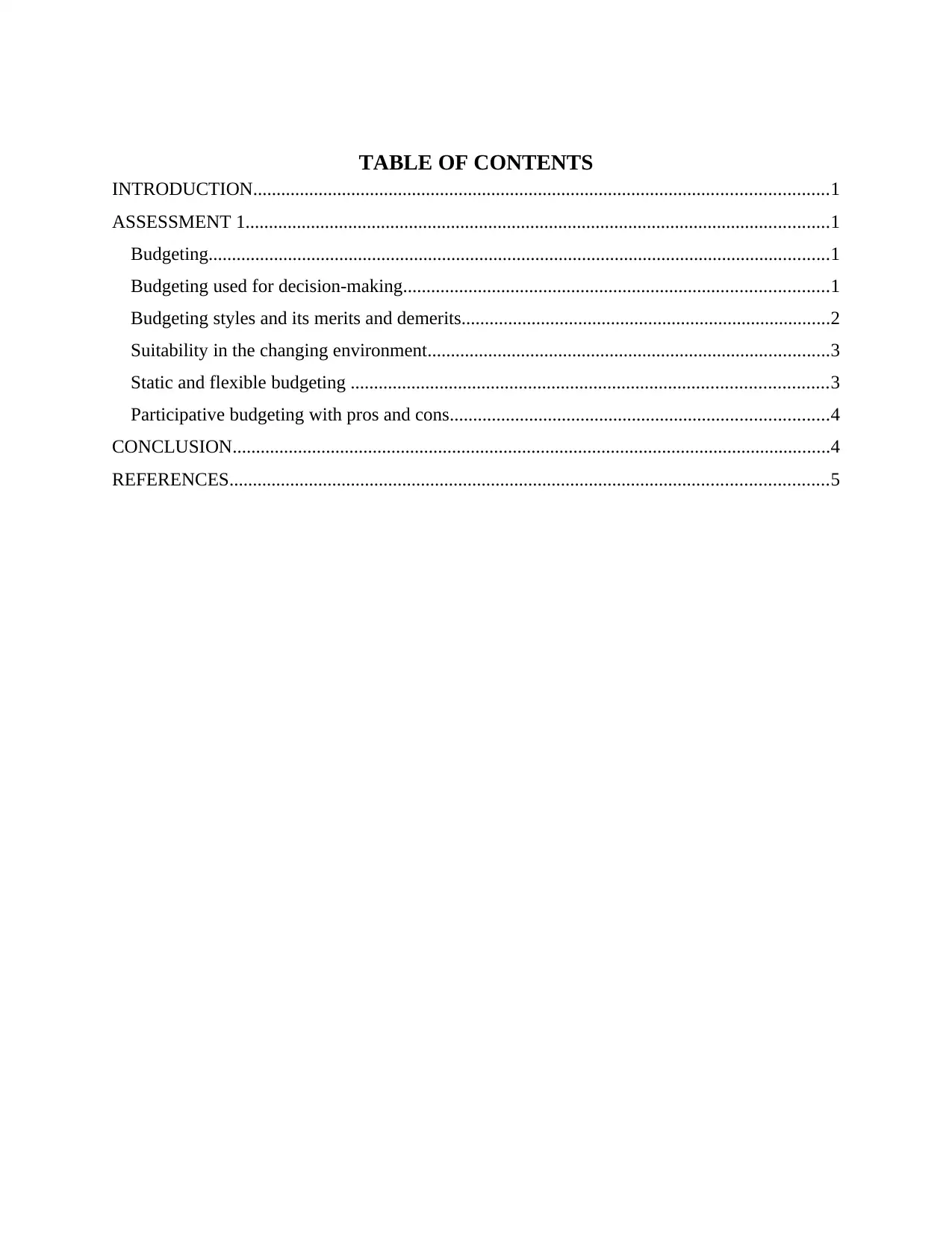
TABLE OF CONTENTS
INTRODUCTION...........................................................................................................................1
ASSESSMENT 1.............................................................................................................................1
Budgeting.....................................................................................................................................1
Budgeting used for decision-making...........................................................................................1
Budgeting styles and its merits and demerits...............................................................................2
Suitability in the changing environment......................................................................................3
Static and flexible budgeting ......................................................................................................3
Participative budgeting with pros and cons.................................................................................4
CONCLUSION................................................................................................................................4
REFERENCES................................................................................................................................5
INTRODUCTION...........................................................................................................................1
ASSESSMENT 1.............................................................................................................................1
Budgeting.....................................................................................................................................1
Budgeting used for decision-making...........................................................................................1
Budgeting styles and its merits and demerits...............................................................................2
Suitability in the changing environment......................................................................................3
Static and flexible budgeting ......................................................................................................3
Participative budgeting with pros and cons.................................................................................4
CONCLUSION................................................................................................................................4
REFERENCES................................................................................................................................5
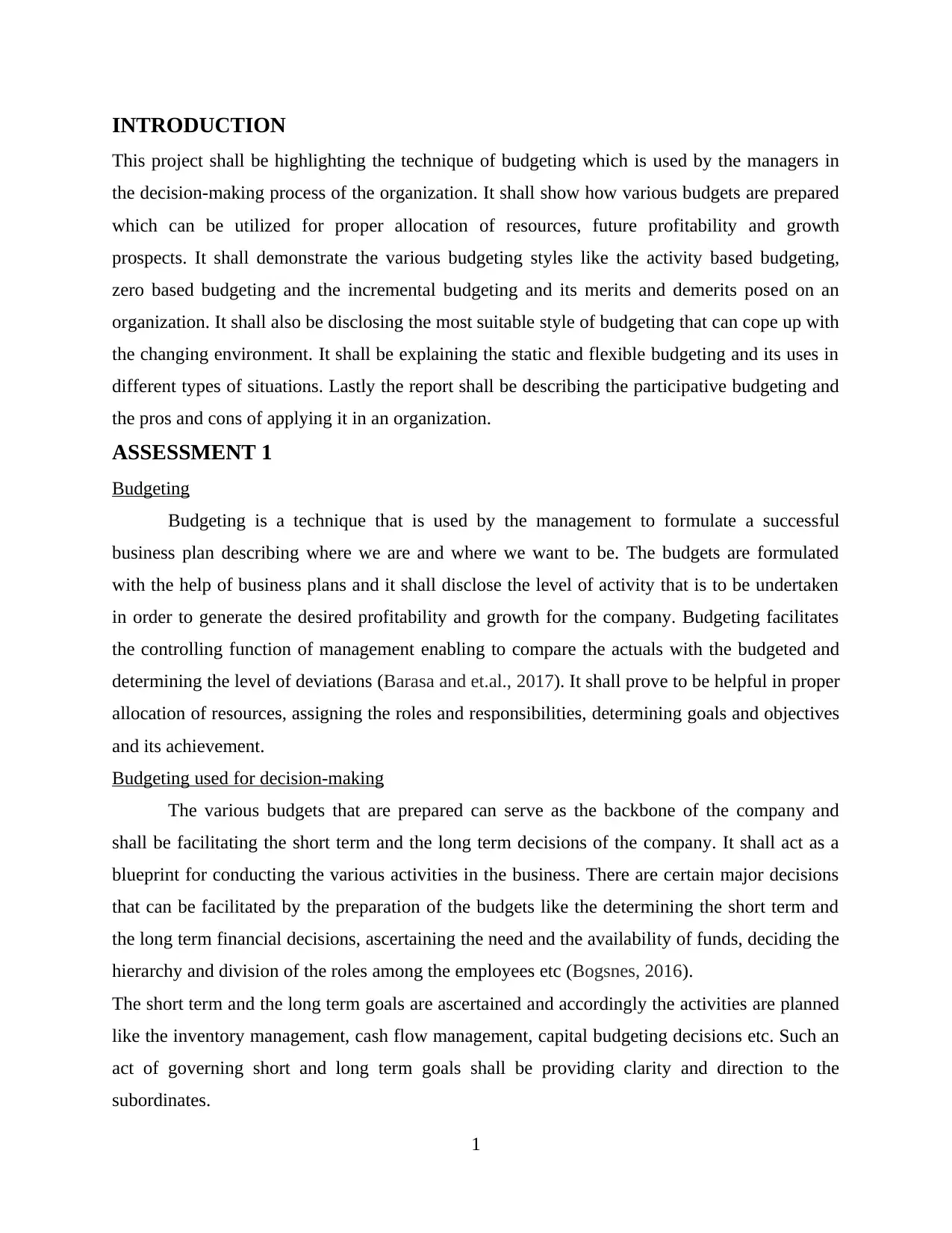
INTRODUCTION
This project shall be highlighting the technique of budgeting which is used by the managers in
the decision-making process of the organization. It shall show how various budgets are prepared
which can be utilized for proper allocation of resources, future profitability and growth
prospects. It shall demonstrate the various budgeting styles like the activity based budgeting,
zero based budgeting and the incremental budgeting and its merits and demerits posed on an
organization. It shall also be disclosing the most suitable style of budgeting that can cope up with
the changing environment. It shall be explaining the static and flexible budgeting and its uses in
different types of situations. Lastly the report shall be describing the participative budgeting and
the pros and cons of applying it in an organization.
ASSESSMENT 1
Budgeting
Budgeting is a technique that is used by the management to formulate a successful
business plan describing where we are and where we want to be. The budgets are formulated
with the help of business plans and it shall disclose the level of activity that is to be undertaken
in order to generate the desired profitability and growth for the company. Budgeting facilitates
the controlling function of management enabling to compare the actuals with the budgeted and
determining the level of deviations (Barasa and et.al., 2017). It shall prove to be helpful in proper
allocation of resources, assigning the roles and responsibilities, determining goals and objectives
and its achievement.
Budgeting used for decision-making
The various budgets that are prepared can serve as the backbone of the company and
shall be facilitating the short term and the long term decisions of the company. It shall act as a
blueprint for conducting the various activities in the business. There are certain major decisions
that can be facilitated by the preparation of the budgets like the determining the short term and
the long term financial decisions, ascertaining the need and the availability of funds, deciding the
hierarchy and division of the roles among the employees etc (Bogsnes, 2016).
The short term and the long term goals are ascertained and accordingly the activities are planned
like the inventory management, cash flow management, capital budgeting decisions etc. Such an
act of governing short and long term goals shall be providing clarity and direction to the
subordinates.
1
This project shall be highlighting the technique of budgeting which is used by the managers in
the decision-making process of the organization. It shall show how various budgets are prepared
which can be utilized for proper allocation of resources, future profitability and growth
prospects. It shall demonstrate the various budgeting styles like the activity based budgeting,
zero based budgeting and the incremental budgeting and its merits and demerits posed on an
organization. It shall also be disclosing the most suitable style of budgeting that can cope up with
the changing environment. It shall be explaining the static and flexible budgeting and its uses in
different types of situations. Lastly the report shall be describing the participative budgeting and
the pros and cons of applying it in an organization.
ASSESSMENT 1
Budgeting
Budgeting is a technique that is used by the management to formulate a successful
business plan describing where we are and where we want to be. The budgets are formulated
with the help of business plans and it shall disclose the level of activity that is to be undertaken
in order to generate the desired profitability and growth for the company. Budgeting facilitates
the controlling function of management enabling to compare the actuals with the budgeted and
determining the level of deviations (Barasa and et.al., 2017). It shall prove to be helpful in proper
allocation of resources, assigning the roles and responsibilities, determining goals and objectives
and its achievement.
Budgeting used for decision-making
The various budgets that are prepared can serve as the backbone of the company and
shall be facilitating the short term and the long term decisions of the company. It shall act as a
blueprint for conducting the various activities in the business. There are certain major decisions
that can be facilitated by the preparation of the budgets like the determining the short term and
the long term financial decisions, ascertaining the need and the availability of funds, deciding the
hierarchy and division of the roles among the employees etc (Bogsnes, 2016).
The short term and the long term goals are ascertained and accordingly the activities are planned
like the inventory management, cash flow management, capital budgeting decisions etc. Such an
act of governing short and long term goals shall be providing clarity and direction to the
subordinates.
1
⊘ This is a preview!⊘
Do you want full access?
Subscribe today to unlock all pages.

Trusted by 1+ million students worldwide
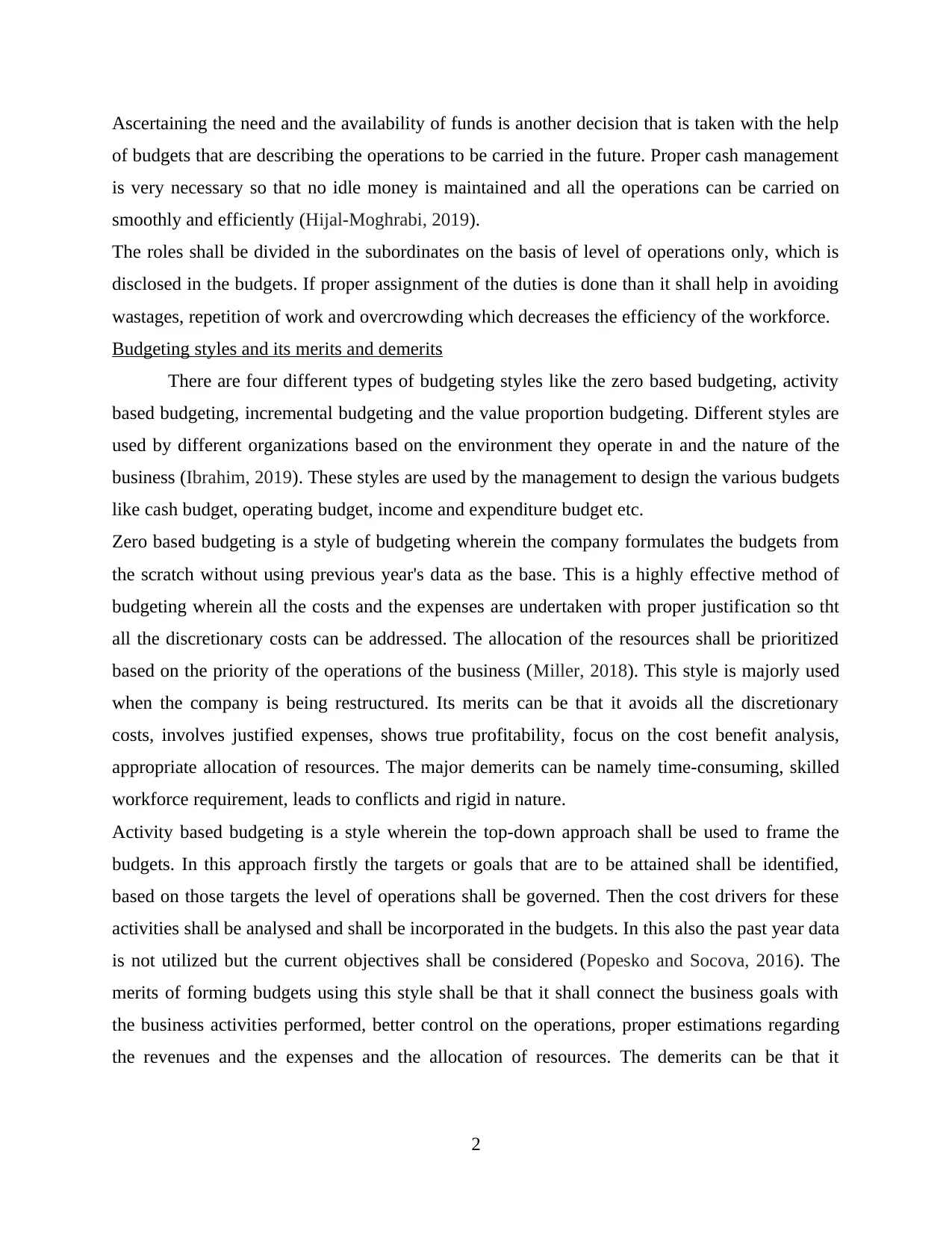
Ascertaining the need and the availability of funds is another decision that is taken with the help
of budgets that are describing the operations to be carried in the future. Proper cash management
is very necessary so that no idle money is maintained and all the operations can be carried on
smoothly and efficiently (Hijal-Moghrabi, 2019).
The roles shall be divided in the subordinates on the basis of level of operations only, which is
disclosed in the budgets. If proper assignment of the duties is done than it shall help in avoiding
wastages, repetition of work and overcrowding which decreases the efficiency of the workforce.
Budgeting styles and its merits and demerits
There are four different types of budgeting styles like the zero based budgeting, activity
based budgeting, incremental budgeting and the value proportion budgeting. Different styles are
used by different organizations based on the environment they operate in and the nature of the
business (Ibrahim, 2019). These styles are used by the management to design the various budgets
like cash budget, operating budget, income and expenditure budget etc.
Zero based budgeting is a style of budgeting wherein the company formulates the budgets from
the scratch without using previous year's data as the base. This is a highly effective method of
budgeting wherein all the costs and the expenses are undertaken with proper justification so tht
all the discretionary costs can be addressed. The allocation of the resources shall be prioritized
based on the priority of the operations of the business (Miller, 2018). This style is majorly used
when the company is being restructured. Its merits can be that it avoids all the discretionary
costs, involves justified expenses, shows true profitability, focus on the cost benefit analysis,
appropriate allocation of resources. The major demerits can be namely time-consuming, skilled
workforce requirement, leads to conflicts and rigid in nature.
Activity based budgeting is a style wherein the top-down approach shall be used to frame the
budgets. In this approach firstly the targets or goals that are to be attained shall be identified,
based on those targets the level of operations shall be governed. Then the cost drivers for these
activities shall be analysed and shall be incorporated in the budgets. In this also the past year data
is not utilized but the current objectives shall be considered (Popesko and Socova, 2016). The
merits of forming budgets using this style shall be that it shall connect the business goals with
the business activities performed, better control on the operations, proper estimations regarding
the revenues and the expenses and the allocation of resources. The demerits can be that it
2
of budgets that are describing the operations to be carried in the future. Proper cash management
is very necessary so that no idle money is maintained and all the operations can be carried on
smoothly and efficiently (Hijal-Moghrabi, 2019).
The roles shall be divided in the subordinates on the basis of level of operations only, which is
disclosed in the budgets. If proper assignment of the duties is done than it shall help in avoiding
wastages, repetition of work and overcrowding which decreases the efficiency of the workforce.
Budgeting styles and its merits and demerits
There are four different types of budgeting styles like the zero based budgeting, activity
based budgeting, incremental budgeting and the value proportion budgeting. Different styles are
used by different organizations based on the environment they operate in and the nature of the
business (Ibrahim, 2019). These styles are used by the management to design the various budgets
like cash budget, operating budget, income and expenditure budget etc.
Zero based budgeting is a style of budgeting wherein the company formulates the budgets from
the scratch without using previous year's data as the base. This is a highly effective method of
budgeting wherein all the costs and the expenses are undertaken with proper justification so tht
all the discretionary costs can be addressed. The allocation of the resources shall be prioritized
based on the priority of the operations of the business (Miller, 2018). This style is majorly used
when the company is being restructured. Its merits can be that it avoids all the discretionary
costs, involves justified expenses, shows true profitability, focus on the cost benefit analysis,
appropriate allocation of resources. The major demerits can be namely time-consuming, skilled
workforce requirement, leads to conflicts and rigid in nature.
Activity based budgeting is a style wherein the top-down approach shall be used to frame the
budgets. In this approach firstly the targets or goals that are to be attained shall be identified,
based on those targets the level of operations shall be governed. Then the cost drivers for these
activities shall be analysed and shall be incorporated in the budgets. In this also the past year data
is not utilized but the current objectives shall be considered (Popesko and Socova, 2016). The
merits of forming budgets using this style shall be that it shall connect the business goals with
the business activities performed, better control on the operations, proper estimations regarding
the revenues and the expenses and the allocation of resources. The demerits can be that it
2
Paraphrase This Document
Need a fresh take? Get an instant paraphrase of this document with our AI Paraphraser
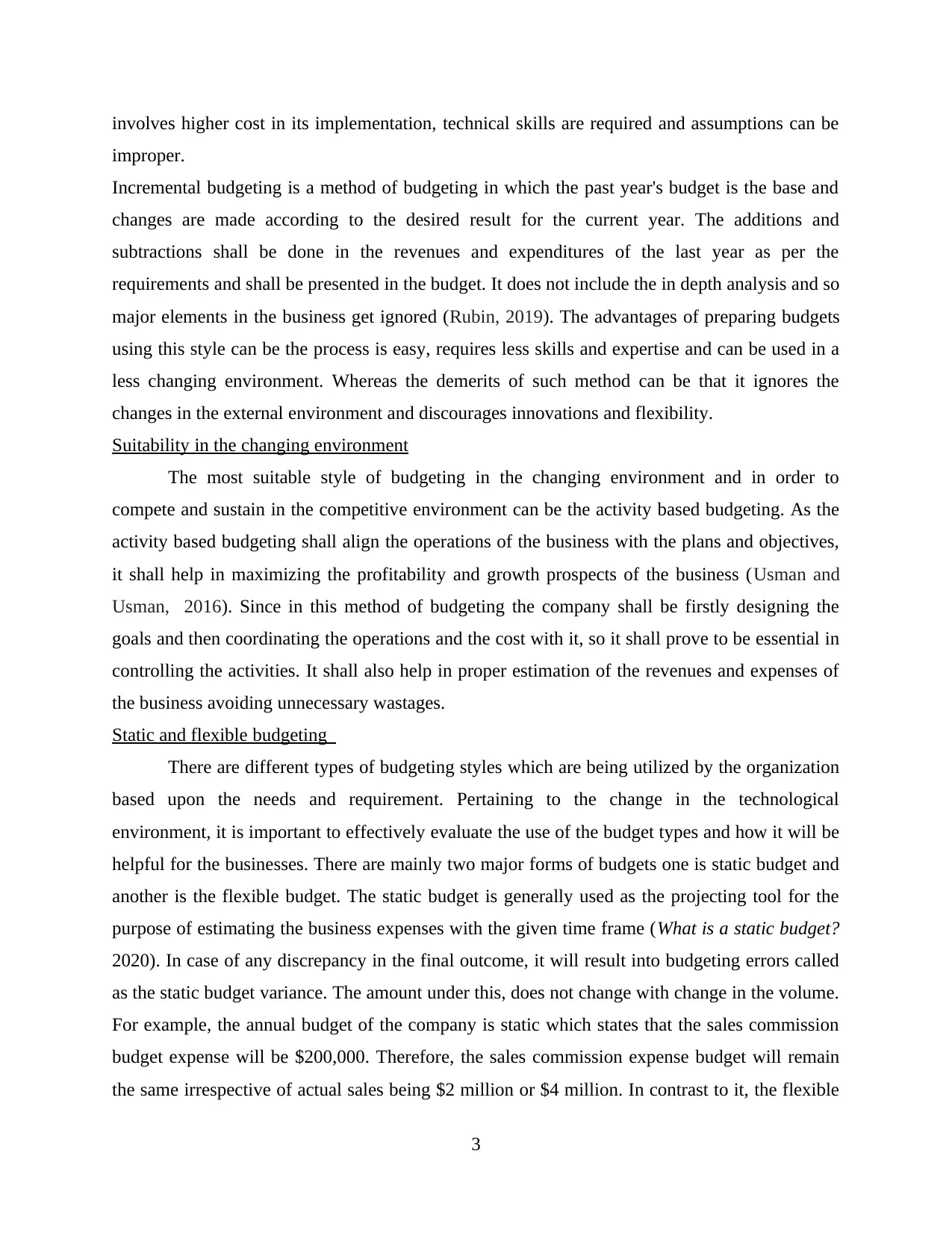
involves higher cost in its implementation, technical skills are required and assumptions can be
improper.
Incremental budgeting is a method of budgeting in which the past year's budget is the base and
changes are made according to the desired result for the current year. The additions and
subtractions shall be done in the revenues and expenditures of the last year as per the
requirements and shall be presented in the budget. It does not include the in depth analysis and so
major elements in the business get ignored (Rubin, 2019). The advantages of preparing budgets
using this style can be the process is easy, requires less skills and expertise and can be used in a
less changing environment. Whereas the demerits of such method can be that it ignores the
changes in the external environment and discourages innovations and flexibility.
Suitability in the changing environment
The most suitable style of budgeting in the changing environment and in order to
compete and sustain in the competitive environment can be the activity based budgeting. As the
activity based budgeting shall align the operations of the business with the plans and objectives,
it shall help in maximizing the profitability and growth prospects of the business (Usman and
Usman, 2016). Since in this method of budgeting the company shall be firstly designing the
goals and then coordinating the operations and the cost with it, so it shall prove to be essential in
controlling the activities. It shall also help in proper estimation of the revenues and expenses of
the business avoiding unnecessary wastages.
Static and flexible budgeting
There are different types of budgeting styles which are being utilized by the organization
based upon the needs and requirement. Pertaining to the change in the technological
environment, it is important to effectively evaluate the use of the budget types and how it will be
helpful for the businesses. There are mainly two major forms of budgets one is static budget and
another is the flexible budget. The static budget is generally used as the projecting tool for the
purpose of estimating the business expenses with the given time frame (What is a static budget?
2020). In case of any discrepancy in the final outcome, it will result into budgeting errors called
as the static budget variance. The amount under this, does not change with change in the volume.
For example, the annual budget of the company is static which states that the sales commission
budget expense will be $200,000. Therefore, the sales commission expense budget will remain
the same irrespective of actual sales being $2 million or $4 million. In contrast to it, the flexible
3
improper.
Incremental budgeting is a method of budgeting in which the past year's budget is the base and
changes are made according to the desired result for the current year. The additions and
subtractions shall be done in the revenues and expenditures of the last year as per the
requirements and shall be presented in the budget. It does not include the in depth analysis and so
major elements in the business get ignored (Rubin, 2019). The advantages of preparing budgets
using this style can be the process is easy, requires less skills and expertise and can be used in a
less changing environment. Whereas the demerits of such method can be that it ignores the
changes in the external environment and discourages innovations and flexibility.
Suitability in the changing environment
The most suitable style of budgeting in the changing environment and in order to
compete and sustain in the competitive environment can be the activity based budgeting. As the
activity based budgeting shall align the operations of the business with the plans and objectives,
it shall help in maximizing the profitability and growth prospects of the business (Usman and
Usman, 2016). Since in this method of budgeting the company shall be firstly designing the
goals and then coordinating the operations and the cost with it, so it shall prove to be essential in
controlling the activities. It shall also help in proper estimation of the revenues and expenses of
the business avoiding unnecessary wastages.
Static and flexible budgeting
There are different types of budgeting styles which are being utilized by the organization
based upon the needs and requirement. Pertaining to the change in the technological
environment, it is important to effectively evaluate the use of the budget types and how it will be
helpful for the businesses. There are mainly two major forms of budgets one is static budget and
another is the flexible budget. The static budget is generally used as the projecting tool for the
purpose of estimating the business expenses with the given time frame (What is a static budget?
2020). In case of any discrepancy in the final outcome, it will result into budgeting errors called
as the static budget variance. The amount under this, does not change with change in the volume.
For example, the annual budget of the company is static which states that the sales commission
budget expense will be $200,000. Therefore, the sales commission expense budget will remain
the same irrespective of actual sales being $2 million or $4 million. In contrast to it, the flexible
3
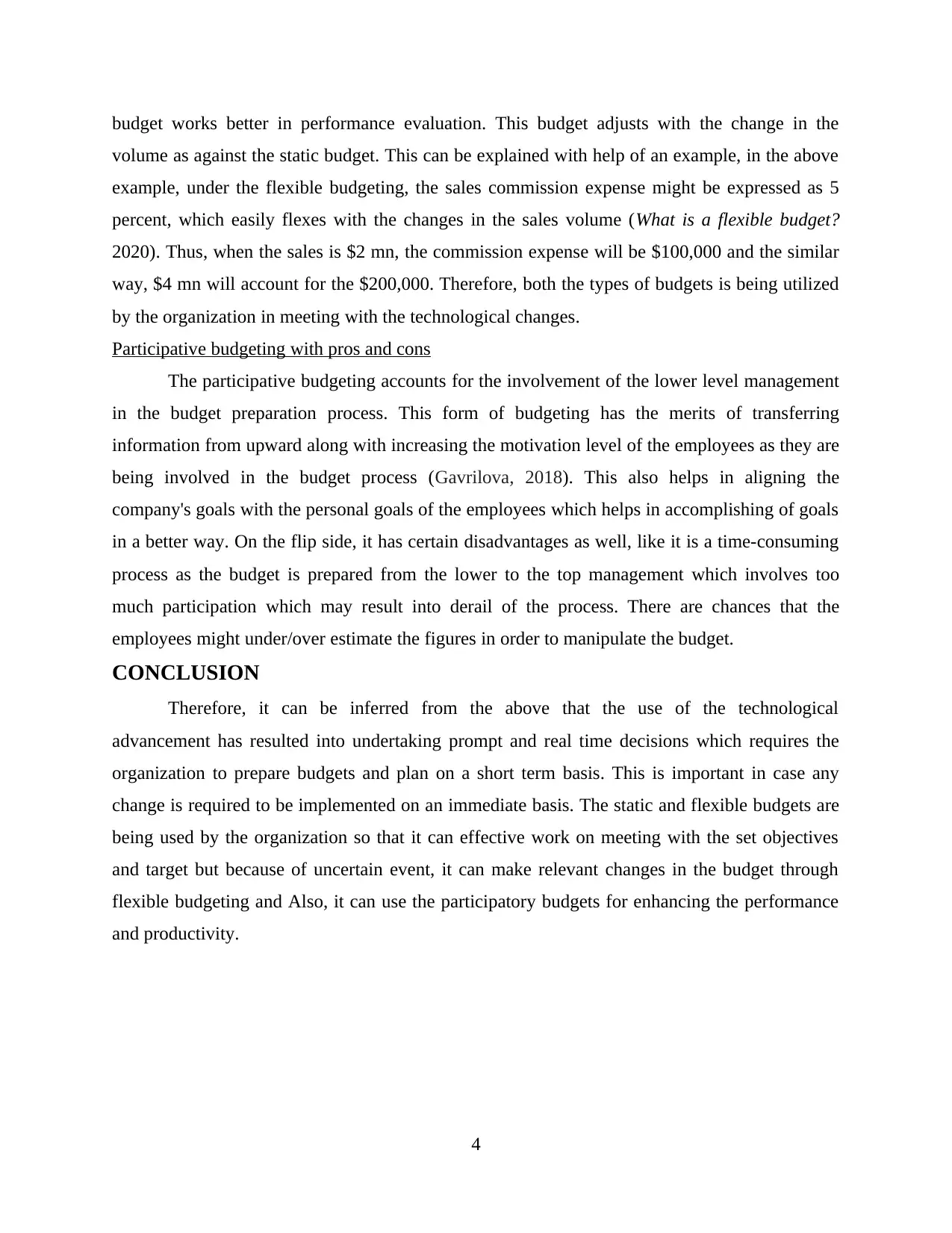
budget works better in performance evaluation. This budget adjusts with the change in the
volume as against the static budget. This can be explained with help of an example, in the above
example, under the flexible budgeting, the sales commission expense might be expressed as 5
percent, which easily flexes with the changes in the sales volume (What is a flexible budget?
2020). Thus, when the sales is $2 mn, the commission expense will be $100,000 and the similar
way, $4 mn will account for the $200,000. Therefore, both the types of budgets is being utilized
by the organization in meeting with the technological changes.
Participative budgeting with pros and cons
The participative budgeting accounts for the involvement of the lower level management
in the budget preparation process. This form of budgeting has the merits of transferring
information from upward along with increasing the motivation level of the employees as they are
being involved in the budget process (Gavrilova, 2018). This also helps in aligning the
company's goals with the personal goals of the employees which helps in accomplishing of goals
in a better way. On the flip side, it has certain disadvantages as well, like it is a time-consuming
process as the budget is prepared from the lower to the top management which involves too
much participation which may result into derail of the process. There are chances that the
employees might under/over estimate the figures in order to manipulate the budget.
CONCLUSION
Therefore, it can be inferred from the above that the use of the technological
advancement has resulted into undertaking prompt and real time decisions which requires the
organization to prepare budgets and plan on a short term basis. This is important in case any
change is required to be implemented on an immediate basis. The static and flexible budgets are
being used by the organization so that it can effective work on meeting with the set objectives
and target but because of uncertain event, it can make relevant changes in the budget through
flexible budgeting and Also, it can use the participatory budgets for enhancing the performance
and productivity.
4
volume as against the static budget. This can be explained with help of an example, in the above
example, under the flexible budgeting, the sales commission expense might be expressed as 5
percent, which easily flexes with the changes in the sales volume (What is a flexible budget?
2020). Thus, when the sales is $2 mn, the commission expense will be $100,000 and the similar
way, $4 mn will account for the $200,000. Therefore, both the types of budgets is being utilized
by the organization in meeting with the technological changes.
Participative budgeting with pros and cons
The participative budgeting accounts for the involvement of the lower level management
in the budget preparation process. This form of budgeting has the merits of transferring
information from upward along with increasing the motivation level of the employees as they are
being involved in the budget process (Gavrilova, 2018). This also helps in aligning the
company's goals with the personal goals of the employees which helps in accomplishing of goals
in a better way. On the flip side, it has certain disadvantages as well, like it is a time-consuming
process as the budget is prepared from the lower to the top management which involves too
much participation which may result into derail of the process. There are chances that the
employees might under/over estimate the figures in order to manipulate the budget.
CONCLUSION
Therefore, it can be inferred from the above that the use of the technological
advancement has resulted into undertaking prompt and real time decisions which requires the
organization to prepare budgets and plan on a short term basis. This is important in case any
change is required to be implemented on an immediate basis. The static and flexible budgets are
being used by the organization so that it can effective work on meeting with the set objectives
and target but because of uncertain event, it can make relevant changes in the budget through
flexible budgeting and Also, it can use the participatory budgets for enhancing the performance
and productivity.
4
⊘ This is a preview!⊘
Do you want full access?
Subscribe today to unlock all pages.

Trusted by 1+ million students worldwide
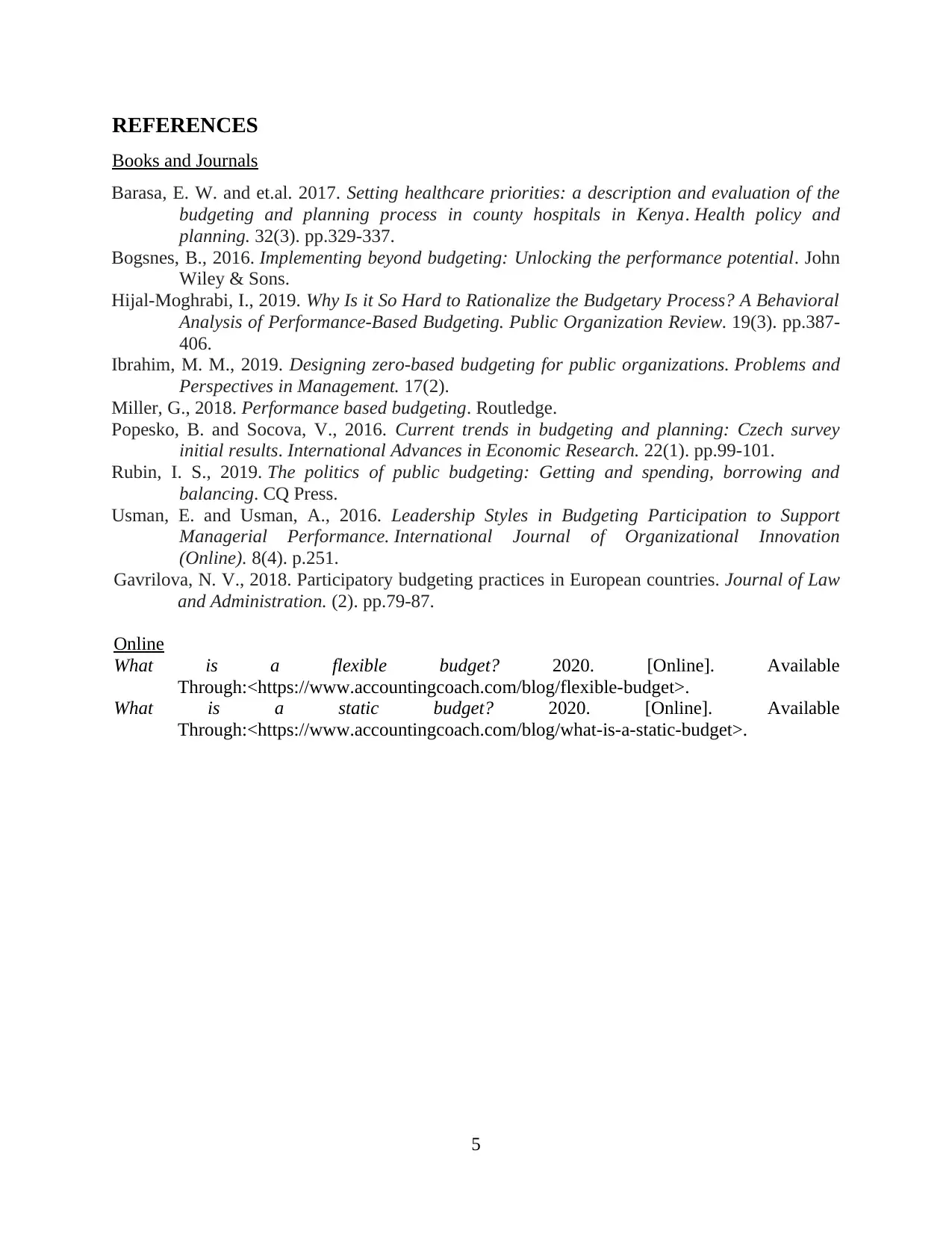
REFERENCES
Books and Journals
Barasa, E. W. and et.al. 2017. Setting healthcare priorities: a description and evaluation of the
budgeting and planning process in county hospitals in Kenya. Health policy and
planning. 32(3). pp.329-337.
Bogsnes, B., 2016. Implementing beyond budgeting: Unlocking the performance potential. John
Wiley & Sons.
Hijal-Moghrabi, I., 2019. Why Is it So Hard to Rationalize the Budgetary Process? A Behavioral
Analysis of Performance-Based Budgeting. Public Organization Review. 19(3). pp.387-
406.
Ibrahim, M. M., 2019. Designing zero-based budgeting for public organizations. Problems and
Perspectives in Management. 17(2).
Miller, G., 2018. Performance based budgeting. Routledge.
Popesko, B. and Socova, V., 2016. Current trends in budgeting and planning: Czech survey
initial results. International Advances in Economic Research. 22(1). pp.99-101.
Rubin, I. S., 2019. The politics of public budgeting: Getting and spending, borrowing and
balancing. CQ Press.
Usman, E. and Usman, A., 2016. Leadership Styles in Budgeting Participation to Support
Managerial Performance. International Journal of Organizational Innovation
(Online). 8(4). p.251.
Gavrilova, N. V., 2018. Participatory budgeting practices in European countries. Journal of Law
and Administration. (2). pp.79-87.
Online
What is a flexible budget? 2020. [Online]. Available
Through:<https://www.accountingcoach.com/blog/flexible-budget>.
What is a static budget? 2020. [Online]. Available
Through:<https://www.accountingcoach.com/blog/what-is-a-static-budget>.
5
Books and Journals
Barasa, E. W. and et.al. 2017. Setting healthcare priorities: a description and evaluation of the
budgeting and planning process in county hospitals in Kenya. Health policy and
planning. 32(3). pp.329-337.
Bogsnes, B., 2016. Implementing beyond budgeting: Unlocking the performance potential. John
Wiley & Sons.
Hijal-Moghrabi, I., 2019. Why Is it So Hard to Rationalize the Budgetary Process? A Behavioral
Analysis of Performance-Based Budgeting. Public Organization Review. 19(3). pp.387-
406.
Ibrahim, M. M., 2019. Designing zero-based budgeting for public organizations. Problems and
Perspectives in Management. 17(2).
Miller, G., 2018. Performance based budgeting. Routledge.
Popesko, B. and Socova, V., 2016. Current trends in budgeting and planning: Czech survey
initial results. International Advances in Economic Research. 22(1). pp.99-101.
Rubin, I. S., 2019. The politics of public budgeting: Getting and spending, borrowing and
balancing. CQ Press.
Usman, E. and Usman, A., 2016. Leadership Styles in Budgeting Participation to Support
Managerial Performance. International Journal of Organizational Innovation
(Online). 8(4). p.251.
Gavrilova, N. V., 2018. Participatory budgeting practices in European countries. Journal of Law
and Administration. (2). pp.79-87.
Online
What is a flexible budget? 2020. [Online]. Available
Through:<https://www.accountingcoach.com/blog/flexible-budget>.
What is a static budget? 2020. [Online]. Available
Through:<https://www.accountingcoach.com/blog/what-is-a-static-budget>.
5
1 out of 7
Related Documents
Your All-in-One AI-Powered Toolkit for Academic Success.
+13062052269
info@desklib.com
Available 24*7 on WhatsApp / Email
![[object Object]](/_next/static/media/star-bottom.7253800d.svg)
Unlock your academic potential
Copyright © 2020–2025 A2Z Services. All Rights Reserved. Developed and managed by ZUCOL.





